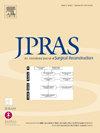基于颅面结构三维 CT 测量的重度颅面微畸形两步聚类分析。
IF 2
3区 医学
Q2 SURGERY
Journal of Plastic Reconstructive and Aesthetic Surgery
Pub Date : 2024-09-19
DOI:10.1016/j.bjps.2024.09.052
引用次数: 0
摘要
背景:普鲁赞斯基-卡班(Pruzansky-Kaban)和奥曼斯(OMENS)分类法没有提供有关颞下颌关节畸形的更多详细信息。本研究的目的是根据颌面部三维测量结果,对严重颅面小畸形进行分类和定量定义,重点是颧骨、颞骨和下颌骨的畸形:方法:收集 2010 年至 2020 年严重颅面小畸形(CFM)儿童的颌面部计算机断层扫描(CT)结果。对颧弓长度、下颌横突高度、上颌骨高度和咬合面进行了三维测量。根据颧弓长度、下颌横突高度和上颌高度的颧弓连续性、咬合斜度以及患侧与非患侧的比率(A/U比率)进行了两步聚类分析:研究共纳入 50 名患者(32 名男性,18 名女性)。通过聚类分析将他们分为两组。聚类 1 包括颧弓连续的受试者(44% 的患者)。第 2 组包括颧弓不连续的受试者(39% 的患者)。第 1 组的颧弓 A/U 比值大于第 2 组,具有统计学意义。此外,第 1 组的上颌骨高度 A/U 比值低于第 2 组,也有统计学意义。第 1 组和第 2 组的颌骨高度 A/U 比和咬合面形在统计学上没有明显差异:根据颅颌面测量结果,严重 CFM 可分为两种类型:连续颧弓和不连续颧弓。该聚类分析是对OMENS分类的补充,有助于为CFM患者选择和设计修复关节。本文章由计算机程序翻译,如有差异,请以英文原文为准。
Two-step cluster analysis based on three-dimensional CT measurements of craniofacial structures in severe craniofacial microsomia
Background
The Pruzansky-Kaban and OMENS classifications do not provide additional details on temporomandibular joint deformities. The aim of this study was to classify and quantitatively define severe forms of craniofacial microsomia based on three-dimensional maxillofacial measurements, focusing on deformities in the zygomatic, temporal, and mandibular bones.
Methods
Maxillofacial computed tomography (CT) scans of children with severe types of craniofacial microsomia (CFM) from 2010 to 2020 were collected. Three-dimensional measurements of zygomatic arch length, height of mandibular ramus, height of maxilla, and occlusal cant were performed. A two-step cluster analysis was conducted based on zygomatic arch continuity, occlusal cant, and the ratio of the affected side to the unaffected side (A/U ratio) for zygomatic arch length, mandibular ramus height, and maxillary height.
Results
Fifty patients (32 male, 18 female) were included in the study. They were classified into 2 clusters through cluster analysis. Cluster 1 comprised subjects (44% of patients) with continuous zygomatic arches. Cluster 2 comprised subjects (39% of patients) with discontinuous zygomatic arches. The zygomatic arch A/U ratio in cluster 1 was greater than that in cluster 2, with statistical significance observed. Additionally, the maxilla height A/U ratio in cluster 1 was lower than in cluster 2, also with statistical significance. There was no statistically significant difference observed in the ramus height A/U ratio and occlusal cant between clusters 1 and 2.
Conclusions
Based on craniofacial measurements, severe CFM can be categorized into two types: continuous zygomatic arch and discontinuous zygomatic arch. This cluster analysis complemented the OMENS classification and could assist in the selection and design of prosthetic joints for patients with CFM.
求助全文
通过发布文献求助,成功后即可免费获取论文全文。
去求助
来源期刊
CiteScore
3.10
自引率
11.10%
发文量
578
审稿时长
3.5 months
期刊介绍:
JPRAS An International Journal of Surgical Reconstruction is one of the world''s leading international journals, covering all the reconstructive and aesthetic aspects of plastic surgery.
The journal presents the latest surgical procedures with audit and outcome studies of new and established techniques in plastic surgery including: cleft lip and palate and other heads and neck surgery, hand surgery, lower limb trauma, burns, skin cancer, breast surgery and aesthetic surgery.

 求助内容:
求助内容: 应助结果提醒方式:
应助结果提醒方式:


